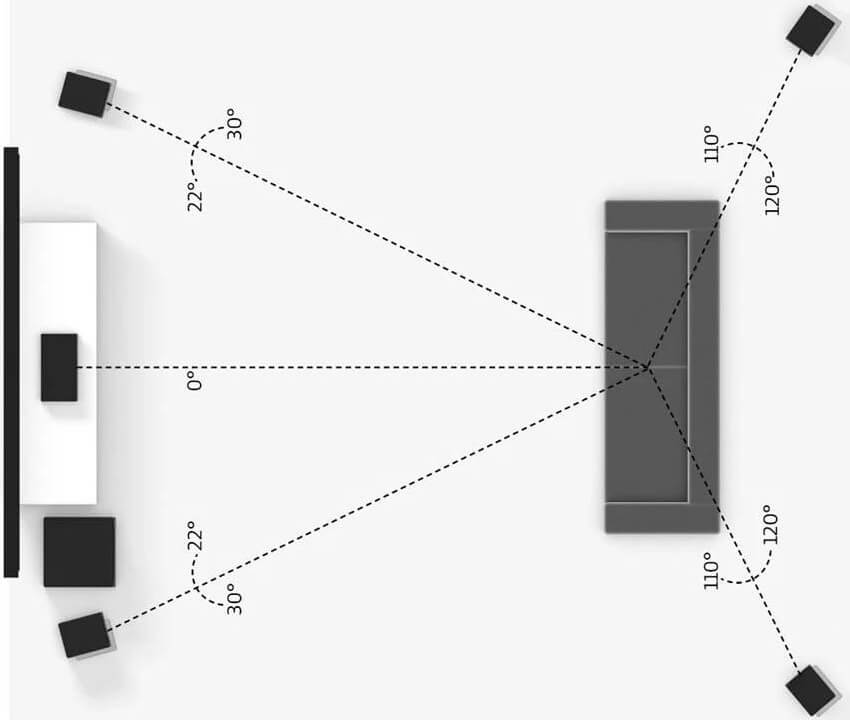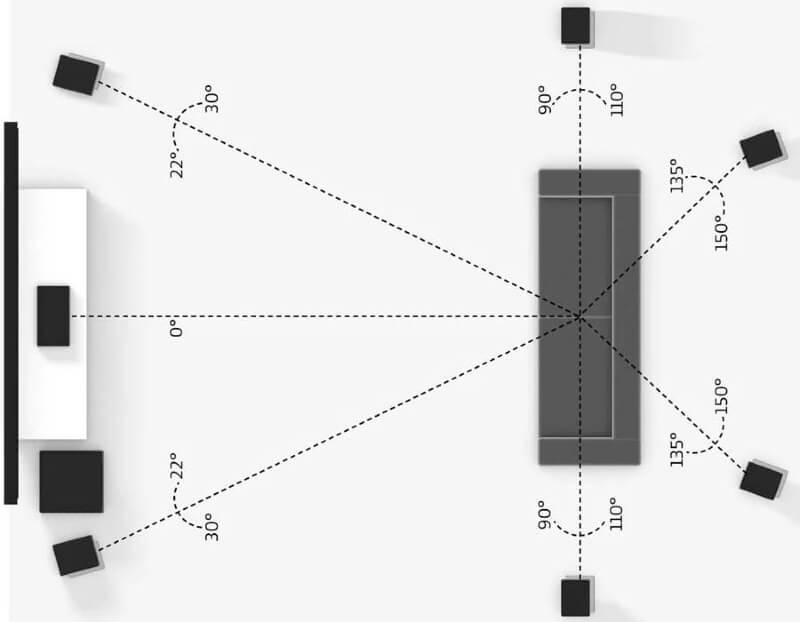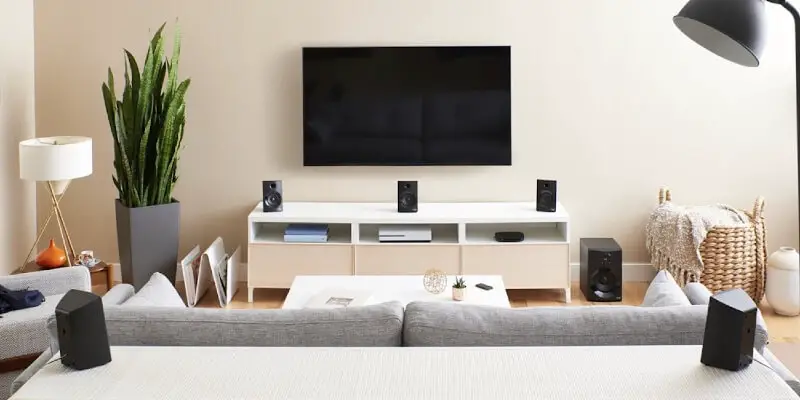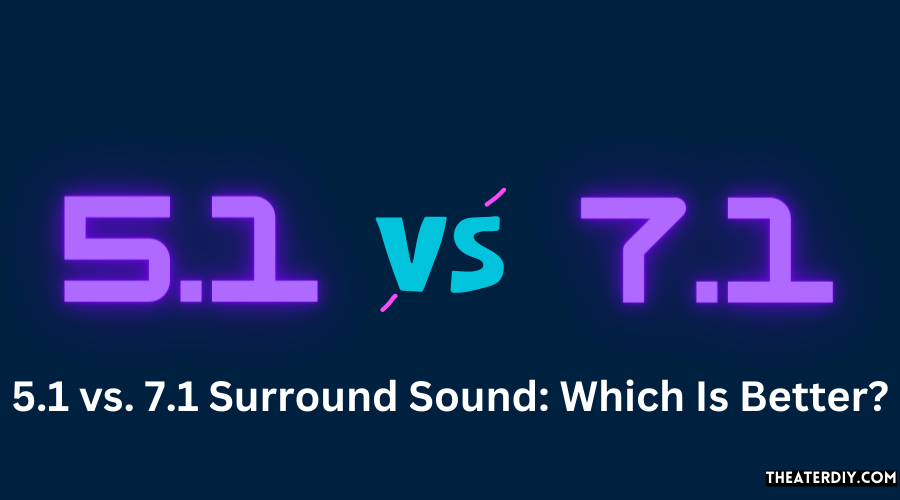A 5.1 system includes five speakers and one subwoofer, while a 7.1 system includes seven speakers and one subwoofer. The addition of two additional surround sound speakers in the 7.1 surround sound system provides depth of sound.
Choosing the Best: 5.1 vs. 7.1 Sound
Finally, after all, you are going to do it. You are saving money for a long time. Now you are going to get the home theater system of your dream. However, when you buy a sound system, a question comes to your mind about exactly what type of good sound system you need to get. Now you can not choose between 5.1 and 7.1 surround sound.
5.1 surround sound is known as surround sound audio system. A good surround sound system that uses five audio channels, which are a front left and right channel, a center channel, two surround channels (left and right) along with the low-frequency effects channels for a subwoofer is called a 5.1 surround sound system. 7.1 surround sound is well known as an eight-channel surround audio system.7.1 sound system is a multichannel sound system same as 5.1 surround sound system, except it, has an additional set of rear(right and left) surround speakers.
Now, which one is better? But unfortunately, it depends on some things. 7.1 or 5.1, which one is best for you depends on several different variables. Something depends on the room you are setting up in; something depends on personal preference.
Some things like listening position, room size, and furnishings will all affect which sound setup is best for you. Now in this content, we will discuss the difference between the 5.1 and 7.1 sound systems is. You can then choose and know the factor’s impact on going for a 5.1 or 7.1.
What’s The difference between 5.1 vs. 7.1 Surround sound?
Simply, The difference between the 5.1 and 7.1 surround sound systems is just two speakers. A 5.1 system is consists of five speakers and a subwoofer; on the other hand, a 7.1 system consists of 7 speakers and one subwoofer.
The 7.1 surround sound system builds based on the 5.1 system to give you two more additional surround sound speakers to add depth to your sound. You can enjoy an incredible listening experience by using it in the right room. If you set up a 7.1 system in the wrong room or improperly, it will sound muddled.
The easiest and most common setup for a 5.1 system is to place three speakers in front of the room (right, left, and center) and two surround sound speakers at either side of the listening area. The 7.1 system improves the 5.1 system by adding two additional surround sound speakers behind the listening area.
5.1 Surround Sounds Pros and Cons

In 5.1 surround sound system, it has several advantages and disadvantages. 7.1 used as a home theater, but it has a diminished size. That’s why the 5.1 system could make more sense for a particular home theater.
The basic level 5.1 system is more common and easy than7.1 the system. That’s why it’s easier to find troubleshooting instructions online. A 5.1 system setup is very easy because it often comes as packages that you can set up right out of the box, also known as a home theater in a box system. If you want to use wires to hook up your system, it will be easier for you because, in the 5.1 system, you will have two fewer wires to hide. Also, a 5.1 system is sufficient in most of the rooms.
But in a bigger room, a 5.1 surround sound system may not be sufficient. If there is a lot of place behind the listen to the area in a big room, the sound may not feel as enveloping as it might in small spaces. Some media comes ready for a 7.1 sound system, but for a 5.1 sound system, they would not be able to deliver as clearly and efficiently, although it’s too rare.
The 5.1 system will do most applicants though some disadvantages might upgrade the 7.1 system more useful.
7.1 Surround Sound Pro and Cons

The 7.1 system has its advantages and disadvantages. Though it needs extra power for additional surround speakers, it may be detrimental to your listening experience. 7.1 system is a better choice than 5.1 for larger rooms where sound may get lost in the open space. You can enjoy a deeper surround sound listening experience with it. A 7.1 system is cleaner than a 5.1 system.
But still, there are some disadvantages to a 7.1 system. The additional surround sound speakers may make the surround sound channels command over the front channels in a smaller room. These can cause some difficulties in hearing the dialogue and front-side sound effects.
Sometimes, few 7.1 systems come as a ready kit and will require you to buy components separately. For this reason, it isn’t easy to find an online community to help troubleshoot your system because the features will be unique to your setup.
A 7.1 sound system can make a better sense in larger rooms and add depth to your sound. Also, a 7.1 system is more expensive and more difficult to set up and troubleshoot than a 5.1 system. Finally, the choice between a 5.1 or 7.1 sound system will depend on one’s particular situation.
5.1 and 7.1 Surround Sound Layout

As I mentioned before, there is a difference between a 5.1 and a 7.1 system in only two surround speakers. These additional surround speakers add depth to the large space of the rooms with theater-quality sound.
There has a fairly standard set up in a 5.1 system. A center speaker always goes below your TV or projector and two front speakers on both sides (right, left) of the TV. Finally, there are two surround speakers which are set up on either side of the listening area.
We know that a 7.1 system adds two additional speakers, but it’s otherwise set up the same way. The other surround speakers are designed so that they can go behind the listening area, and their main purpose is to send sound at a different angle than the first set of surround speakers.
It’s is not very rare for these speakers to be mounted in the ceiling. There is some advantage to ceiling mounting because it gives us an interesting sound experience, and it keeps the place behind the listening area free for walking.
What’s Right for Your Room?

Several things are going to affect which sound system is appropriate for your room. You want an enormous theater-quality sound from a 7.1 system, and it doesn’t mean you will get it in any room. There are three major characteristics of rooms to determine what kind of sound system is right for them.
Room Size: Additional speakers are used to filling up larger rooms. Many speakers can make a muddy mix of sounds that sound louder than the clear sound in a small space. Generally, if your room is smaller than 350 square feet, you should not use a 7.1 system.
Listening Position: The main difference between the 5.1 and 7.1 systems is that the larger system puts speakers behind the listeners to give them a full surround sound experience. If you don’t have much space behind the listening area, it doesn’t make any sense to put the speaker back there.
Furnishings: The hard materials like tables, desks, cabinets, and wood or tile flooring will reflect sound and ruin the effect of additional speakers. On the other hand, soft surfaces such as bookshelves, couches, and carpeting will help prevent sound reflection and keep the sounds in the parts of the rooms where they are supposed to be.
Features and Your Budget
If you want to pick up your ideal sound system, you have to look up several things. Most of the features will be a matter of weighing your budget against the perks of a better setup.
Generally, a 7.1 system will be more expensive than a 5.1 system. It has more components so that it can give you a richer sound experience. Moreover, different factors will impact the expenses of your system.
Receiver: For running your sound system, you will need a receiver that converts a line-level signal from your TV into a speaker-level signal for your speakers. Most of the 5.1 systems come with a receiver included, but few 7.1 systems come as an all-inclusive package. Though not as ideal as getting a coherent 7.1 speaker set, you should always start with a 5.1 system and upgrade into a 7.1 receiver and two additional speakers later.
Wires: Another fact that you may want to consider is how you intend to hook up your sound system. Most of the system comes with wireless capability, and setting up speakers around the room less of a tangle. Moreover, what you gain in convenience, you will lose that in sound quality. A direct wired signal is always better and higher than the quality you get to form a wireless connection. Ultimately, you will need to decide what do you need?
Calibration: Provide your internal calibration; there are many systems on the market. These systems will optimize your sound by sending test tones from each speaker to a microphone that you set up in the primary listening area of your room. These systems are more common with 7.1 systems and expensive.
Price Different Between 5.1 and 7.1 Surround Sound System

One of the most concluding factors between whether getting a 5.1 or 7.1 system is price. If you want to save cash, you can get a 5.1 surround sound package at a very fair price.
You get what you are paying for, but these systems may not be sufficient for your needs. If you want to get a top brand 5.1 sound system like Klipsch, you may pay about $6,000. This system comes with a high definition theater-quality sound, and a receiver included.
If you plan to get a 7.1 surround sound system, you can expect to pay at least $500 more for a decent system. Of course, this won’t get you a very high-quality sound. Getting a good 7.1 surround sound system with a receiver can cost you from $1,000 to $13,000.
After upgrading a 5.1 to 7.1 surround sound system, there comes a more variety of in-wall or in-ceiling speakers system to choose from it. Though these look aesthetical, they will require a professional to install. Another defect is that upgrading to a different system means pulling speakers out of the wall/ceiling and patching the hole.
So What’s The Verdict?

It seems very hard to build the home theater of your dreams, but it doesn’t have to be confusing. To make your work easier, consider making a list of must-have features and a list of features that would be nice to have. It’s a good idea because it helps to come up with a budget before you start browsing.
The key to being successful is, to be honest with yourself about your needs. The 7.1 surround sound system might seem like a cool status symbol, but it may ruin the sound if placed in the wrong room. The features of the space where you are working must keep in your mind so that you can choose the system that will be best for you. We hope that, with these tips, you will be on your way to creating your perfect home theater experience.
-our editorial board has reviewed this article and has been approved for publication according to our editorial policy.
Best Seller List of Surround Sound System:

- Low-Profile Modern Design - Clean silhouettes, subtle textures, and matte finishes seamlessly blend into any environment.
- Powerful Performance - Brilliant clarity, thunderous bass, and Dolby Audio and DTS Digital Surround support combine for performance beyond its size.
- Simple Setup, Streaming & Control - Get setup and listening in minutes with HDMI ARC and Bluetooth connectivity for unparalleled ease of use, control, and access to your content.
- 5.1-Channel Sound - Experience a powerful room-filling, surround sound experience.
- 6 Total Speakers - Full-range drivers deliver coherent sound and brilliant clarity.


- Your purchase includes: 1 AV receiver, 5 speakers, 1 Sub-Woofer and Speaker wire.Waterproof : No
- Dimensions: AV Receiver – 17” W x 6” H x 12” D | Four Speakers (each) – 4” W x 6” H x 4” D | Center speaker – 10” W x 4” H x 4” D | Subwoofer – 11” W x 11” H x 13” D
- Technical specs: HDMI – 4 | Standby Power Consumption – ≤ 0.2 W | Frequency Response – 28Hz/25kHz
- Bluetooth for streaming all your favorite music and podcasts. No wireless functionality
- Easy setup with Yamaha YPAO room optimization and flexible speaker placement options, including virtual cinema front


- 5.1-channel 80-Watt powerful surround sound system
- 4K60, 4K120AB and 8K60B HDMI 2.1 with HDCP 2.3 and eARC (4 in/1 out)
- Dolby Vision, Hybrid Log-Gamma and BT.2020
- Supports enhanced media and gaming - ALLM, VRR
- YPAO automatic room calibration


- Include 2 Surround Sound Rear Speakers: This 5.1 channel soundbar for tv comes with 2 rear speakers and 1 subwoofer, which brings you the cinematic experience with our decoded playback device. A 19.6 feet cable is used to connect surround speakers to subwoofer so you can place surround sound speakers anywhere given your preference.
- Immersive Surround Sound by SurroundX Technology: SurroundX algorithm converts 2.0 PCM to 5.1 surround signal, which makes sound move around you. ULTIMEA tv sound bar uses aerospace-grade magnets to have speakers deliver clear and distinct surround sound. Volume of surround speakers can be adjusted to 3 levels by pressing surround button on the remote.
- Deep, Room-Filling Bass with Ultimate BassMAX Technology: To deliver a deep and powerful bass, this surround sound system for tv applies BassMAX Technology, enhanced magnetic circuit design, and a larger cabinet to this surround sound system for tv. Volume of subwoofer can be adjusted to 3 levels by pressing bass button on the remote.
- Customized Bass and Surround Sound: You can completely control your audio environment by adjusting the surround and bass volume given your preference, creating a truly bespoke audio experience. ULTIMEA sound bar for smart tv with subwoofer owns 3 models at different scenes for you: movie, dialogue, and music. You can switch it to any mode with one press on the remote controller.
- Easy to set up & Decent Design: ULTIMEA sound bars for tv support multiple wired and wireless connection. With the help of ULTIMEA clear instructions, you can easily set it up and start exploring the fun of surround sound. This decent soundbar with subwoofer also allows you to place it on stand, cabinet or under the TV. Perfectly fit your bedroom and living room.


- The Klipsch reference theater pack delivers a superior acoustic performance while keeping an incredibly minimal footprint
- Klipsch's exclusive Tractrix Horn technology and aluminum Tweeters deliver the cleanest, most natural sound possible. The down-firing wireless subwoofer is designed to deliver room-filling low frequencies without requiring too much floor space
- To complement the easy placement of the wireless subwoofer, each satellite speaker has a keyhole mount and a threaded insert for maximum mounting flexibility
- The reference theater pack brings the Klipsch cinematic sound into your home with an incredibly minimal footprint


- 5.1 Channel Surround Stereo Sound: Bobtot surround sound system has two modes of 5.1/2.1 channel, switch via remote control or front panel. Pro surround function provides you with more advanced enjoyment. Via the Remote you can also independently control the volume of each speaker and the subwoofer.
- 800W Peak Power: Home theater system speakers can reach up to 800 watts of power, 6.5 inch Subwoofer with a built-in receiver, high volume but with professional sound quality and excellent bass sound, deliver the cleanest, most natural sound possible. Bring you and your family with full cinema experience at home.
- 5.0 Bluetooth Connection & 2 Wireless Rear Satellite Speakers: The 2 front speakers with built-in cable to connect with the subwoofer, 2 wireless rear satellite speakers are long enough can be placed anywhere. The wireless rear speakers usually are connected automatically when the home stereo system is turned on. Cable Length: Front Speakers L/R: 13Ft, Center Speaker: 13Ft. Bluetooth 5.0 technology supports you to directly connect with Bluetooth devices.
- Multimedia Supported: 5.0 Bluetooth speakers can connect to various smart devices, and support multiple input modes like TV ARC/OPT/COA/AUX/USB/DVD, Additional cables include HDMI ARC cable/Optical cable/Coaxial cable/RCA cable/Antenna cable/Aux cable that can support any application in need.
- Home Surround Sound Speakers: Bobtot surround sound speakers use Top quality MDF wood cabinets with plastic front panels, and have LED lighting effects and digital display functions. It also have a built-In FM Receiver with Amazing Reception. USB input. 2 ¼” MIC Inputs with Echo function for karaoke.


- THE ULTIMATE HOME THEATER EXPERIENCE: Our 5.1 speaker system includes 5 speakers and 1 subwoofer; Delivers powerful surround sound while watching TV, gaming, or streaming music from your phone to the built in Bluetooth receiver
- LED ILLUMINATED SURROUND SOUND: Each system features an integrated power amp with 300 watts of power while the LED illuminated subs display multi colored flashing lights in a variety of different patterns
- GREAT FOR AT HOME ENTERTAINMENT: Use our sound equipment for binge-watching your favorite TV shows, for movie nights at home with the family, or for gaming on your computer, or for listening to music on your MP3 player
- SYSTEM REQUIREMENTS: Our system is compatible with any standard 3.5 millimeter headphones, RCA stereo, or RCA 6 Channel surround audio outputs, and features a standard US 110V grounded wall plug
- WHAT'S IN THE BOX: Acoustic Audio by Goldwood AA5400 powered subwoofer speaker, 5 passive wired satellite speakers, full function remote, 3.5 millimeter to RCA cable, 3 RCA to RCA jack cables, and an instruction manual


- 4x Klipsch Satellite Speakers - Center Speaker - Subwoofer - Transmitter - Klipsch 5 Year Limited Warranty - Onkyo TX-NR696 7.2-Channel Network A/V Receiver - Remote Control, 2x AAA Batteries - Onkyo 2 Year Limited Warranty
- The Klipsch reference theater pack delivers a superior acoustic performance while keeping an incredibly minimal footprint
- Klipsch's exclusive Tractrix Horn technology and aluminum Tweeters deliver the cleanest, most natural sound possible. The down-firing wireless subwoofer is designed to deliver room-filling low frequencies without requiring too much floor space
- To complement the easy placement of the wireless subwoofer, each satellite speaker has a keyhole mount and a threaded insert for maximum mounting flexibility
- The reference theater pack brings the Klipsch cinematic sound into your home with an incredibly minimal footprint


- Feel every note with a 600W power output
- Get the best seat in the house with 5.1ch real surround sound
- Rear speakers deliver powerful surround sound to complete your home cinema experience
- Effortless setup with easy color-coded connections
- Wireless connectivity for music streaming


- 5.1 digital surround sound: Hear every detail in your Dolby Digital and DTS soundtracks the way the studio intended. Sub woofer: 165 Watts.Waterproof : No
- THX certified home theater speakers: Your assurance of true cinema quality sound. Satellites : 4 x 67 W, wall mountable
- Delivers a continuous 500 watts of power, with the ability to deliver a peak of 1,000 watts under certain circumstances: Provides rich audio and thunderous bass that let you truly hear and feel every detail
- Flexible setup: Connect upto six devices : Computer, music player, TV, game console and more; Infared remote
- Easy sound control: Compact control console and wireless remote let you instantly personalize your surround sound experience, Digital optical input: 2 (up to 1080p)
Last update on 2024-04-25

